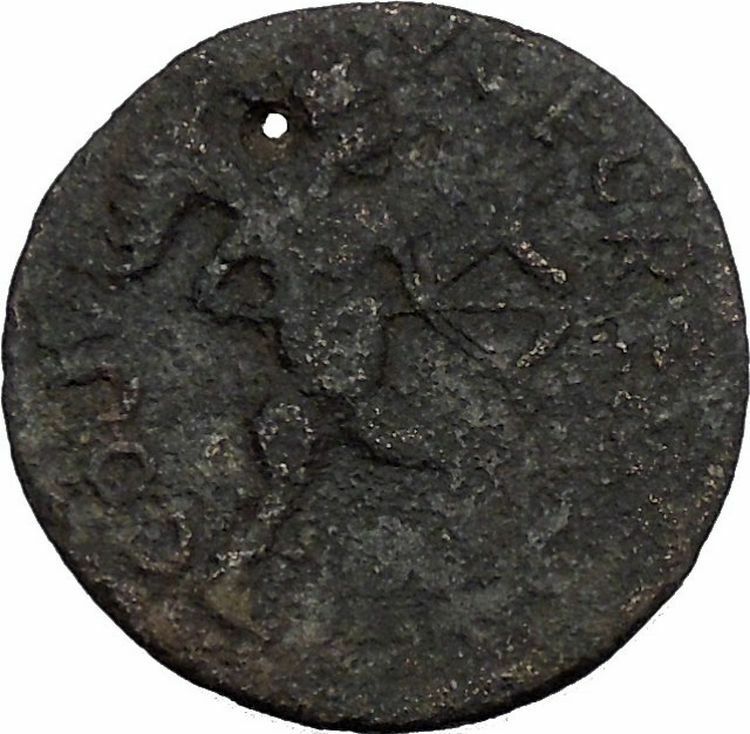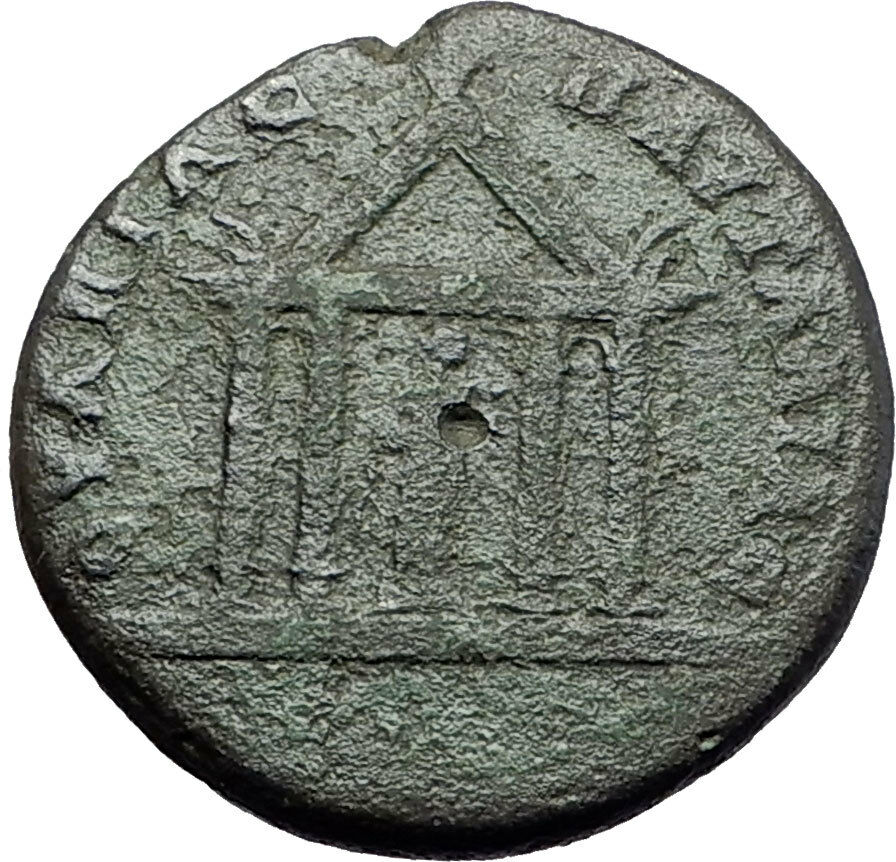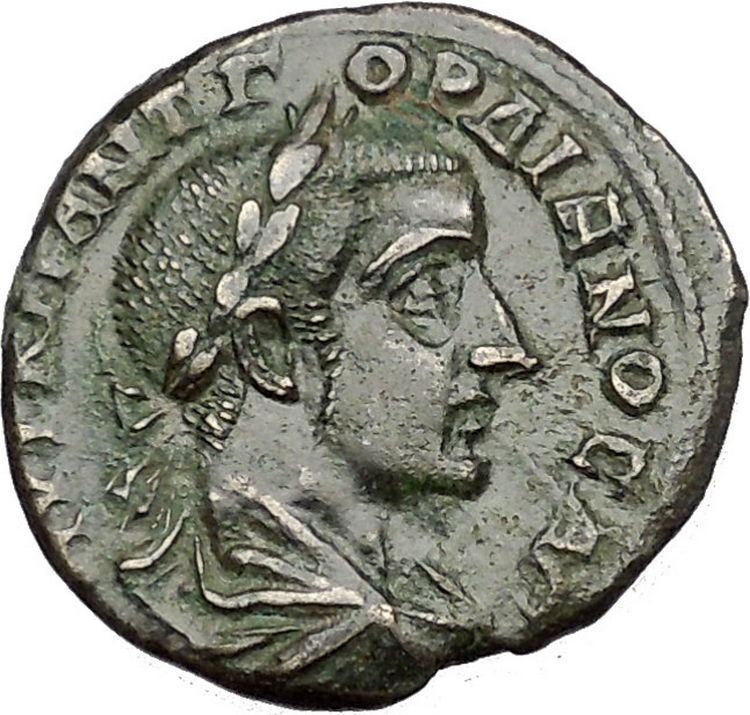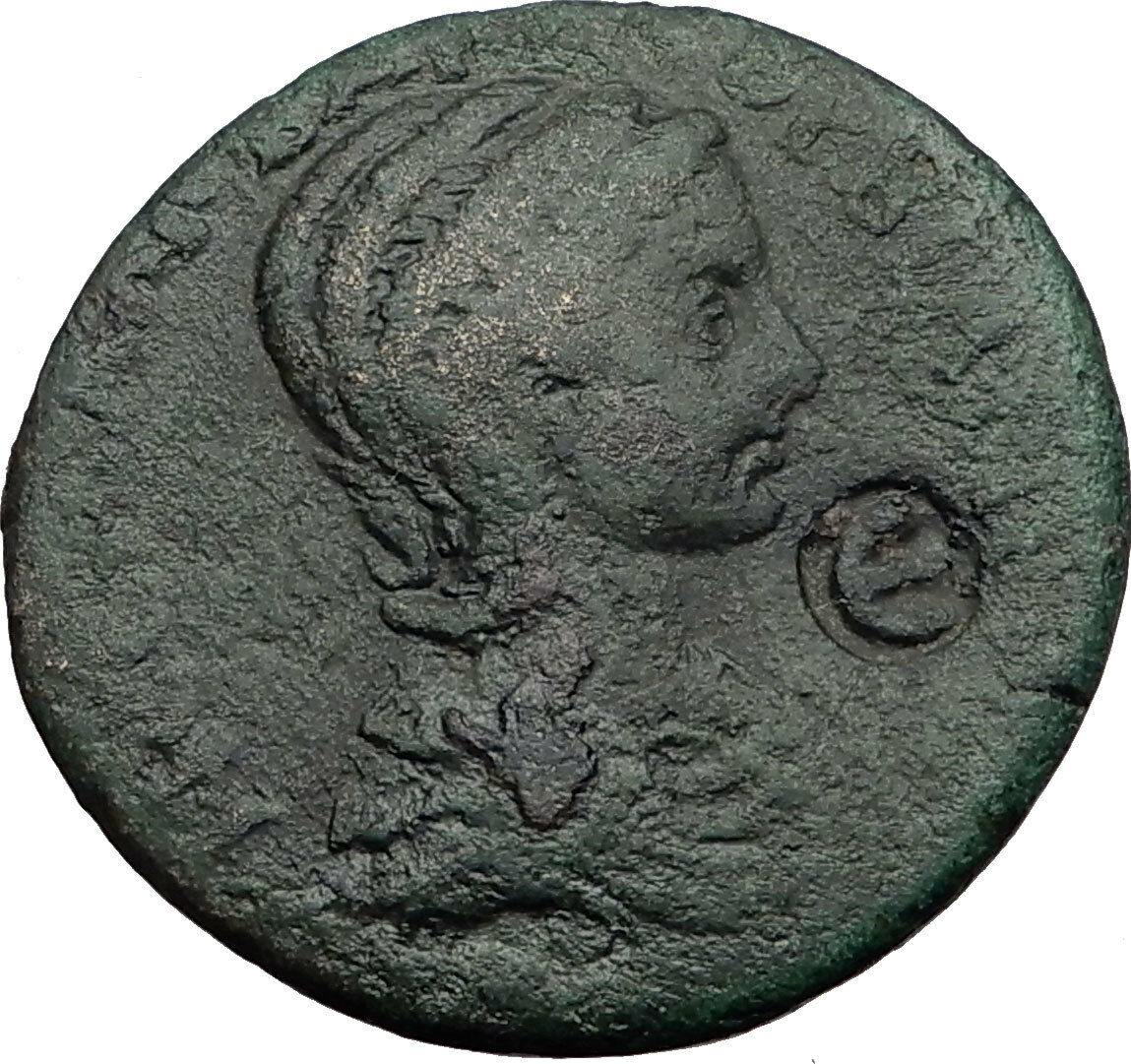|
Septimius Severus
–
Roman Emperor
: 193-211 A.D. –
Bronze 16mm (2.60 grams)of
Ephesus
in
Ionia
Reference: BMC 262.
AV KAI Λ CEOVHPOC, Laureate head right.
EΦECIΩN, Stag standing right.
You are bidding on the exact item pictured,
provided with a Certificate of Authenticity and Lifetime Guarantee of
Authenticity.<=”” font=”” color=”#000000″><=”” p=””>
<=”” font=”” color=”#000000″>
Ephesus (Ancient
Greek Ἔφεσος,
Turkish
Efes) was an ancient Greek city
on the west coast of
Anatolia
, near present-day
Selçuk
,
Izmir Province
,
Turkey
. It was one of the twelve cities of the
Ionian League
during the
Classical Greek
era. In the Roman period, it
was for many years the second largest city of the
Roman Empire
; ranking behind
Rome, the empire’s capital. Ephesus had a population of more than
250,000 in the 1st century BC, which also made it the second largest city in the
world.
<=”” font=”” color=”#000000″>
The city was famed for the
Temple of Artemis
(completed around 550 BCE),
one of the
Seven Wonders of the Ancient World
. The Temple
was destroyed in 401 CE by a mob led by St.
John Chrysostom
. Emperor
Constantine I
rebuilt much of the city and
erected new public baths. The town was again partially destroyed by an
earthquake in 614. The city’s importance as a commercial center declined as the
harbor was slowly silted up by the
Cayster River
(Küçük Menderes).
Ephesus was one of the
seven churches of Asia
that are cited in the
Book of Revelation
. The
Gospel of John
may have been written here. It
is also the site of a large
gladiators
‘ graveyard.
Today’s archaeological site lies 3 kilometers southwest of
the town of Selçuk
, in the Selçuk district of
İzmir Province
,
Turkey
. The
ruins
of Ephesus are a favorite international
and local tourist attraction, partly owing to their easy access from
Adnan Menderes Airport
and via the port of
Kuşadası
.
History
Neolithic
age
The area surrounding Ephesus was already inhabited during the
Neolithic Age (about 6000 BCE), as was revealed by the excavations at the nearby
hoyuk (artificial mounds known as
tells) of Arvalya and Cukurici.. Bronze
age
Excavations in recent years have unearthed settlements from
the early Bronze Age
at the Ayasuluk Hill. In 1954 a
burial ground from the
Mycenaean
era (1500-1400 BCE) with ceramic pots
was discovered close to the ruins of the basilica of St. John.[8]
This was the period of the Mycenaean Expansion when the
Achaioi (as they were called by
Homer
) settled in
Ahhiyawa
during the 14th and 13th centuries
BCE. Scholars believe that Ephesus was founded on the settlement of Apasa (or
Abasa), a
Bronze Age
-city noted in 14th-century BCE
Hittite
sources as in the land of
Ahhiyawa
.
[9]
Dark
age

Site of the
Temple of Artemis
in the town of
Selçuk
, near Ephesus.
The city of Ephesus itself was founded as an
Attic-Ionian colony in the 10th century BCE on the Ayasuluk Hill, three
kilometers from the center of antique Ephesus (as attested by excavations at the
Seljuk
castle during the 1990s). The mythical
founder of the city was a prince of
Athens
named
Androklos
, who had to leave his country after
the death of his father, King Kadros. According to legend, he founded Ephesus on
the place where the oracle of
Delphi
became reality (“A fish and a boar will
show you the way”). Androklos drove away most of the native
Carian
and
Lelegian
inhabitants of the city and united his
people with the remainder. He was a successful warrior and, as king, he was able
to join the twelve cities of
Ionia
together into the
Ionian League
. During his reign the city began
to prosper. He died in a battle against the Carians when he came to the aid of
Priene
, another city of the Ionian League.[10]
Androklos and his dog are depicted on the Hadrian temple frieze, dating from the
second century. Later, Greek historians such as
Pausanias
,
Strabo
and the poet Kallinos, and the historian
Herodotos
however reassigned the city’s
mythological foundation to Ephos, queen of the
Amazons
.
The Greek goddess
Artemis
and the great Anatolian goddess
Kybele
were identified together as Artemis
of Ephesus. The many-breasted “Lady of Ephesus”, identified with
Artemis
, was venerated in the
Temple of Artemis
, one of the
Seven Wonders of the World
and the largest
building of the ancient world according to
Pausanias
(4.31.8). Pausanius mentions that the
temple was built by Ephesus, son of the river god
Caystrus
.[11]
before the arrival of the Ionians. Of this structure, scarcely a trace remains.
Archaic
period
About 650 BCE, Ephesus was attacked by the
Cimmerians
, who razed the city, including the
temple of Artemis. A few small Cimmerian artifacts can be seen at the
archaeological museum of Ephesus.
When the Cimmerians had been driven away, the city was ruled
by a series of tyrants. After a revolt by the people, Ephesus was ruled by a
council called the Kuretes. The city prospered again, producing a number
of important historical figures, such as the
iambic
poets
Callinus
[12]
and the satirist
Hipponax
, the philosopher
Heraclitus
, the great painter
Parrhasius
and later the grammarian
Zenodotos
, the physicians
Soranus
and Rufus.
About 560 BCE Ephesus was conquered by the
Lydians
under the mighty king
Croesus
. He treated the inhabitants with
respect, despite ruling harshly, and even became the main contributor to the
reconstruction of the temple of Artemis.[13]
His signature has been found on the base of one of the columns of the temple
(now on display in the
British Museum
). Croesus made the populations
of the different settlements around Ephesus regroup (synoikismos)
in the vicinity of the Temple of Artemis, enlarging the city.
Later in the same century, the Lydians under Croesus invaded
Persia. The Ionians refused a peace offer from
Cyrus the Great
, siding with the Lydians
instead. After the Persians defeated Croesus the Ionians offered to make peace
but Cyrus insisted that they surrender and become part of the empire. They were
defeated by the Persian army commander
Harpagos
in 547 BCE. The Persians then
incorporated the Greek cities of Asia Minor into the
Achaemenid Empire
. Those cities were then ruled
by satraps
.
Ephesus has intrigued archaeologists for the main reason that
for the Archaic Period, there is no definite location for the settlement. There
are numerous sites to suggest the movement of a settlement between the Bronze
Age and the Roman period but the silting up of the natural harbors as well as
the movement of the Kayster River meant that the location never remainded the
same.
Classical
period
Ephesus continued to prosper. But when taxes continued to be
raised under
Cambyses II
and
Darius
, the Ephesians participated in the
Ionian Revolt
against Persian rule in the
Battle of Ephesus (498 BCE)
, an event which
instigated the
Greco-Persian wars
. In 479 BCE, the Ionians,
together with Athens
and
Sparta
, were able to oust the Persians from
Anatolia. In 478 BCE, the Ionian cities entered with Athens and Sparta into the
Delian League
against the Persians. Ephesus did
not contribute ships but gave financial support by offering the treasure of
Apollo
to the goddess
Athena
, protectress of Athens.
During the
Peloponnesian War
, Ephesus was first allied to
Athens[citation
needed] but sided in a later phase, called the Decelean
War, or the Ionian War, with Sparta, which also had received the support of the
Persians. As a result, rule over the kingdoms of Anatolia was ceded again to
Persia.
These wars did not much affect daily life in Ephesus. The
Ephesians were surprisingly modern in their social relations. They allowed
strangers to integrate. Education was much valued. Through the cult of Artemis,
the city also became a bastion of women’s rights. Ephesus even had its female
artists. In later times,
Pliny the Elder
mentioned having seen at
Ephesus a representation of the goddess
Diana
by Timarata, the daughter of a painter.
In 356 BCE the temple of Artemis was burned down, according
to legend, by a lunatic called Herostratus. By coincidence, this was the night
that
Alexander the Great
was born. The inhabitants
of Ephesus at once set about restoring the temple and even planned a larger and
grander one than the original.
Hellenistic
period

Historical map of Ephesus, from
Meyers Konversationslexikon
,
1888
When
Alexander the Great
defeated the Persian forces
at the
Battle of Granicus
in 334 BCE, the Greek cities
of Asia Minor were liberated. The pro-Persian tyrant Syrpax and his family were
stoned to death, and Alexander was greeted warmly when he entered Ephesus in
triumph. When Alexander saw that the temple of Artemis was not yet finished, he
proposed to finance it and have his name inscribed on the front. But the
inhabitants of Ephesus demurred, claiming that it was not fitting for one god to
build a temple to another. After Alexander’s death in 323 BCE, Ephesus in 290
BCE came under the rule of one of Alexander’s generals,
Lysimachuss
.
Cayster silted up the harbor, the resulting marshes
caused malaria and many deaths among the inhabitants. The people of Ephesus were
forced to move to a new settlement two kilometers further on, when the king
flooded the old city by blocking the sewers. This settlement was called after
the king’s second wife,
Arsinoe II of Egypt
. After
Lysimachus
had destroyed the nearby cities of
Lebedos
and
Colophon
in 292 BCE, he relocated their
inhabitants to the new city. The architectural layout of the city would remain
unchanged for the next 500 years.
Ephesus revolted after the treacherous death of
Seleucus I Nicator Agathocles
an opportunity for removing and killing Lysimachus, his last rival, at the
Battle of Corupedium
in 281 BCE. After the
death of Lysimachos the town took again the name of Ephesus.
Thus Ephese became part of the
Seleucid Empire
. After the murder of king
Antiochus II Theos
and his Egyptian wife,
pharaoh
Ptolemy III
invaded the Seleucid Empire and the
Egyptian fleet swept the coast of Asia Minor. Ephesus came under Egyptian rule
between 263-197 BCE.
When the Seleucid king
Antiochus III the Great
tried to regain the
Greek cities of Asia Minor, he came in conflict with
Rome. After a series of battles, he was defeated by
Scipio Asiaticus
at the
Battle of Magnesia
in 190 BCE. As a result,
Ephesus came under the rule of the Attalid king of
Pergamon
Eumenes II
(197-133 BCE). When his grandson
Attalus III
died without male children of his
own, he left his kingdom to the
Roman Republic
LL ucius Septimius Severus (or rarely Severus I) (April 11, ucius Septimius Severus (or rarely Severus I) (April 11,
145/146-February 4, 211) was a
Roman
general, and
Roman
Emperor
from April 14, 193 to 211. He was born in what is now the
Berber
part of
Rome’s historic
Africa Province
.
Septimius Severus was born and raised at
Leptis
Magna
(modern Berber
, southeast of
Carthage
,
modern Tunisia
).
Severus came from a wealthy, distinguished family of
equestrian
rank. Severus was of
Italian
Roman ancestry on his mother’s side and of
Punic
or
Libyan
-Punic
ancestry on his father’s. Little is known of his father,
Publius Septimius Geta
, who held no major political status but had two
cousins who served as consuls under emperor
Antoninus Pius
. His mother, Fulvia Pia’s family moved from
Italy
to
North
Africa
and was of the
Fulvius
gens,
an ancient and politically influential clan, which was originally of
plebeian
status. His siblings were a younger
Publius Septimius Geta
and Septimia Octavilla. Severus’s maternal cousin was
Praetorian Guard
and consul
Gaius Fulvius Plautianus
.
In 172, Severus was made a
Senator
by the then emperor
Marcus Aurelius
. In 187 he married secondly
Julia
Domna
. In 190 Severus became
consul
, and in
the following year received from the emperor
Commodus
(successor to Marcus Aurelius) the command of the
legions
in Pannonia
.
On the murder of
Pertinax
by
the troops in 193, they proclaimed Severus Emperor at
Carnuntum
,
whereupon he hurried to Italy. The former emperor,
Didius Julianus
, was condemned to death by the Senate and killed, and
Severus took possession of Rome without opposition.
The legions of
Syria
, however, had proclaimed
Pescennius Niger
emperor. At the same time, Severus felt it was reasonable
to offer
Clodius Albinus
, the powerful governor of Britannia who had probably
supported Didius against him, the rank of Caesar, which implied some claim to
succession. With his rearguard safe, he moved to the East and crushed Niger’s
forces at the
Battle of Issus
. The following year was devoted to suppressing Mesopotamia
and other Parthian vassals who had backed Niger. When afterwards Severus
declared openly his son
Caracalla
as successor, Albinus was hailed emperor by his troops and moved to Gallia.
Severus, after a short stay in Rome, moved northwards to meet him. On
February
19
, 197
,
in the
Battle of Lugdunum
, with an army of 100,000 men, mostly composed of
Illyrian
,
Moesian
and
Dacian
legions,
Severus defeated and killed Clodius Albinus, securing his full control over the
Empire.
Emperor
Severus was at heart a
soldier
, and
sought glory through military exploits. In 197 he waged a brief and successful
war against the
Parthian Empire
in retaliation for the support given to Pescennius Niger.
The Parthian capital
Ctesiphon
was sacked by the legions, and the northern half of
Mesopotamia
was restored to Rome.
His relations with the
Roman
Senate
were never good. He was unpopular with them from the outset, having
seized power with the help of the military, and he returned the sentiment.
Severus ordered the execution of dozens of Senators on charges of corruption and
conspiracy
against him, replacing them with his own favorites.
He also disbanded the
Praetorian Guard
and replaced it with one of his own, made up of 50,000
loyal soldiers mainly camped at
Albanum
, near Rome (also probably to grant the emperor a kind of centralized
reserve). During his reign the number of legions was also increased from 25/30
to 33. He also increased the number of auxiliary corps (numerii), many of
these troops coming from the Eastern borders. Additionally the annual wage for a
soldier was raised from 300 to 500
denarii
.
Although his actions turned Rome into a military
dictatorship
, he was popular with the citizens of Rome, having stamped out
the rampant corruption of Commodus’s reign. When he returned from his victory
over the Parthians, he erected the
Arch of Septimius Severus
in Rome.
According to Cassius Dio,
however, after 197 Severus fell heavily under the influence of his Praetorian
Prefect,
Gaius Fulvius Plautianus
, who came to have almost total control of most
branches of the imperial administration. Plautianus’s daughter,
Fulvia Plautilla
, was married to Severus’s son, Caracalla. Plautianus’s
excessive power came to an end in 205, when he was denounced by the Emperor’s
dying brother and killed.
The two following praefecti, including the jurist
Aemilius Papinianus
, received however even larger powers.
Campaigns in Caledonia (Scotland)
Starting from 208 Severus undertook a number of military actions in
Roman
Britain
, reconstructing
Hadrian’s Wall
and campaigning in
Scotland
.
He reached the area of the
Moray
Firth
in his last campaign in Caledonia, as was called Scotland by
the Romans..
In 210 obtained a peace with the
Picts
that lasted
practically until the final withdrawal of the Roman legions from Britain,
before falling severely ill in
Eboracum
(York).
Death
He is famously said to have given the advice to his sons: “Be harmonious,
enrich the soldiers, and scorn all other men” before he died at Eboracum on
February 4
,
211. Upon his death in 211, Severus was
deified
by the Senate and succeeded by his sons,
Caracalla
and
Geta
, who were advised by his wife
Julia
Domna
. The stability Severus provided the Empire was soon gone under their reign.
Accomplishments and Record
Though his military expenditure was costly to the empire, Severus was the
strong, able ruler that Rome needed at the time. He began a tradition of
effective emperors elevated solely by the military. His policy of an expanded
and better-rewarded army was criticized by his contemporary
Dio Cassius
and
Herodianus
: in particular, they pointed out the increasing burden (in the
form of taxes and services) the civilian population had to bear to maintain the
new army.
Severus was also distinguished for his buildings. Apart from the triumphal
arch in the Roman Forum carrying his full name, he also built the
Septizodium
in Rome and enriched greatly his native city of
Leptis
Magna
(including another triumphal arch on the occasion of his visit of
203).
Severus and Christianity
Christians were
persecuted
during the reign of Septimus Severus. Severus allowed the
enforcement of policies already long-established, which meant that Roman
authorities did not intentionally seek out Christians, but when people were
accused of being Christians they could either curse
Jesus
and make an
offering to
Roman gods
, or be executed. Furthermore, wishing to strengthen the peace by
encouraging religious harmony through
syncretism
,
Severus tried to limit the spread of the two quarrelsome groups who refused to
yield to syncretism by outlawing
conversion
to Christianity or
Judaism
.
Individual officials availed themselves of the laws to proceed with rigor
against the Christians. Naturally the emperor, with his strict conception of
law, did not hinder such partial persecution, which took place in
Egypt
and the
Thebaid
, as
well as in
Africa proconsularis
and the East. Christian
martyrs
were
numerous in Alexandria
(cf.
Clement of Alexandria
, Stromata, ii. 20;
Eusebius
, Church History, V., xxvi., VI., i.). No less severe were
the persecutions in Africa, which seem to have begun in 197 or 198 (cf.
Tertullian’s
Ad martyres), and included the Christians known in the
Roman martyrology
as the martyrs of
Madaura
.
Probably in 202 or 203
Felicitas
and
Perpetua
suffered for their faith. Persecution again raged for a short time
under the proconsul
Scapula
in
211, especially in
Numidia
and
Mauritania
.
Later accounts of a Gallic
persecution, especially at
Lyon, are
legendary. In general it may thus be said that the position of the Christians
under Septimius Severus was the same as under the
Antonines
;
but the law of this Emperor at least shows clearly that the
rescript
of
Trajan
[
neededclarification] had failed to execute its purpose.
|






 ucius Septimius Severus (or rarely Severus I) (April 11,
ucius Septimius Severus (or rarely Severus I) (April 11, 


